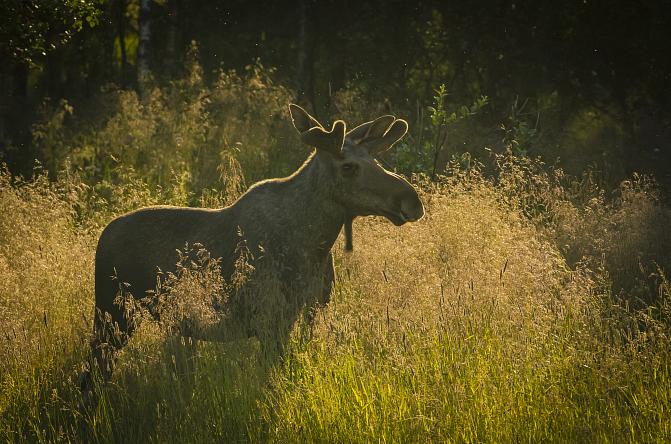Modelling tools for wolf population management
A mathematical model is like a scale model of an animal community’s activities. It helps identify the complex interrelationships of species and address them in wolf-related decisions.
Large carnivores (bears, wolves, lynx and wolverines) and even-toed ungulates (elk, white-tailed deer, roe deer and wild forest reindeer) are part of Finnish nature. Different species interact with each other: one hunts the other, while some compete for the same nutrition. Diverse population management addresses dependences and interaction between species. For example, elk hunting plans must take the fact that elk are hunted by wolves and bears into account.
It may be relatively simple to see what impact a wolf pack has on elk in its territory. What if bears or white-tailed deer also live in the same area? What will happen to wolves if the elk hunting quota is changed? The more species, areas or other details are added to the equation, the more difficult it is to see the big picture.
A mathematical model is an extension of the brain. Modelling, mathematics and computer programming are tools that help compile information that would otherwise be difficult to comprehend. If a model has been built as a sufficiently detailed representation of the current state, it can be used to predict the future and assess the impact of decisions on animal communities.
Goal:
Developing two tools to merge and perceive datasets to support the authorities, administration and decision-makers. The first will illustrate the impact of different population control measures on the population dynamics of deer and large carnivores; the other will compile wolf-related information to support wilderness supervision.
Measures:
- A multi-species game was built during the project. It is a model that illustrates the impact of different population control measures on the population dynamics of deer and large carnivores. It is openly accessible online.
- A tool was developed for the authorities to support wilderness supervision activities and prevent various conflicts caused by wolves.
Results
The multi-species game illustrates the nutrition network formed by different species
The multi-species game is an interactive tool in which users can select two deer species and two large carnivores that hunt them to test different situations: for example, what would happen if animals were not hunted at all, or if a species disappeared from the area? Users can also set target sizes for deer and large carnivores to see whether the targets set for all species can be achieved at the same time.
The game offers an overview of how multi-species population management works, and what kinds of interrelationships different species can have. It is especially intended for hunting planners and others interested in the theme.
Although the game illustrates the nutrition network between animals, it is based on simplifications. The game is not directly applicable to practical hunting plans.
The multi-species game was planned in cooperation and has been demonstrated broadly
A diverse group of stakeholders participated in the design of the multi-species game, including representatives of the authorities, administration, nature conservation, hunting, reindeer husbandry and domestic animal farming. At two joint meetings, the participants considered the challenges to which the tool should respond, and the variables and measures it should measure.
The game was demonstrated and used at meetings held by the Finnish Wildlife Agency in elk population regions. Meetings were also held for regional wildlife councils and other stakeholders, and the game was demonstrated at meetings for elk population regulation planning and at other training events. In 2021–2024, some 2,200 people participated in various events.
The Finnish Wildlife Agency’s personnel thought that the multi-species game provided some help in illustrating the interrelationships of large carnivores. All the various factors that affect the diverse group of predator and prey species, as well as animal populations, make the tool difficult to grasp, however.
The official tool assists in wolf-related wilderness supervision
The official tool is used by certain employees of the Police of Finland, Metsähallitus, the Finnish Border Guard and Finnish Customs. Although the tool is developed by Luke, it can only be accessed by technical administrators.
The tool collects datasets on a map that the wilderness supervision authorities have previously needed to retrieve from several different systems. Such datasets include wolf sightings in the Tassu system, wolf territories based on the population estimate, the results of DNA analyses and the estimated distance of the sightings from residential buildings.
The more detailed content of the official tool is confidential in accordance with section 24, paragraph 4 of the Act on the Openness of Government Activities, similar to many other systems used by the police and other supervisory authorities.
Modelling is developing in the wildlife sector
The work started in the LIFE BOREALWOLF project to develop modelling in the wildlife sector will continue in other projects. Luke has developed the mathematical model that operates in the background of the multi-species game to be more detailed and more representative of natural phenomena. The aim is that the model can predict the regional densities of different species in Finland several years ahead.
The effectiveness of the model calls for research data on animal ecology. For example, this data can be obtained from field studies in which roe deer, white-tailed deer and lynx are collared. The aim is to identify what impact carnivores have on the reproduction of prey species, the survival of calves and their movement in the region. This data can be used to specify the modelled estimates.

